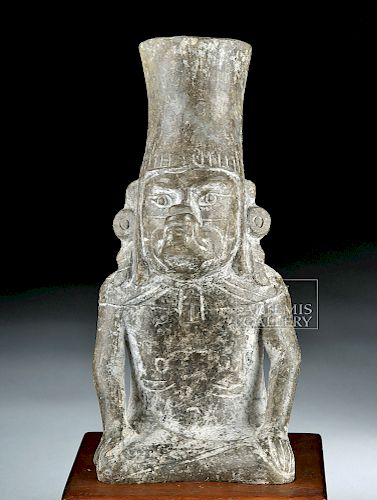Zapotec Ceramic Effigy Vessel - Seated Figure / Cociyo
Lot 11a
About Seller
Artemis Fine Arts
686 S Taylor Ave, Ste 106
Louisville, CO 80027
United States
Selling antiquities, ancient and ethnographic art online since 1993, Artemis Gallery specializes in Classical Antiquities (Egyptian, Greek, Roman, Near Eastern), Asian, Pre-Columbian, African / Tribal / Oceanographic art. Our extensive inventory includes pottery, stone, metal, wood, glass and textil...Read more
Estimate:
$4,000 - $6,000
Absentee vs Live bid
Two ways to bid:
- Leave a max absentee bid and the platform will bid on your behalf up to your maximum bid during the live auction.
- Bid live during the auction and your bids will be submitted real-time to the auctioneer.
Bid Increments
| Price | Bid Increment |
|---|---|
| $0 | $25 |
| $300 | $50 |
| $1,000 | $100 |
| $2,000 | $250 |
| $5,000 | $500 |
| $10,000 | $1,000 |
| $20,000 | $2,500 |
| $50,000 | $5,000 |
| $100,000 | $10,000 |
| $200,000 | $20,000 |
About Auction
By Artemis Fine Arts
May 10, 2018
Set Reminder
2018-05-10 10:00:00
2018-05-10 10:00:00
America/New_York
Bidsquare
Bidsquare : Fine Ethnographic / Asian / Ancient Art
https://www.bidsquare.com/auctions/artemis-gallery/fine-ethnographic-asian-ancient-art-3213
Featuring antiquities from around the world including Pre-Columbian, Tribal, Classical, Asian, so much more! Artemis Fine Arts info@artemisgallery.com
Featuring antiquities from around the world including Pre-Columbian, Tribal, Classical, Asian, so much more! Artemis Fine Arts info@artemisgallery.com
- Lot Description
Pre-Columbian, Oaxaca, Mexico, Zapotec culture, Monte Alban, ca. 100 BCE to 200 CE. A detailed example of one of the most famous forms of Monte Alban pottery, a figural vessel made from crema paste ceramics. These elaborately decorated items were produced as prestige items and local lords in the Monte Alban area received them via gift-giving networks that reinforced their power and prestige. This particular vessel is in the form of a seated human figure wearing the mask of a god - probably Cociyo/Cocijo, god of rain, based on the shape of the mask, but it is difficult to see if the figure has the forked tongue that most Cociyo figures do. Atop the head is a long, flaring, conical spout. The figure is seated, with crossed legs, muscular arms, and hands resting against the knees. The mask gives the figure a zoomorphic snout. He wears two enormous spooled earrings in addition to his headdress. Size: 3.3" W x 7.15" H (8.4 cm x 18.2 cm); 8.55" H (21.7 cm) on included custom stand. Size: 3.3" W x 7.15" H (8.4 cm x 18.2 cm); 8.55" H (21.7 cm) on included custom stand.
The Zapotec, like many pre-Columbian civilizations, placed clay effigies into burials, often in the form of urns or vessels. Who are the figures depicted on vessels like this one, and what was their purpose? They may represent the deities themselves or magical spirits, but more likely, they seem to represent ancestors or shamans impersonating gods.
Provenance: ex-private New England, USA collection, acquired in the 1970s
All items legal to buy/sell under U.S. Statute covering cultural patrimony Code 2600, CHAPTER 14, and are guaranteed to be as described or your money back.
A Certificate of Authenticity will accompany all winning bids.
We ship worldwide and handle all shipping in-house for your convenience.
#133145Spout has been repaired; otherwise intact. Nice light encrusted deposits and root marks. Label on the base of the stand is likely incorrect, but cannot be removed without damaging the stand.Condition
- Shipping Info
-
All shipping is handled in-house for your convenience. Your invoice from Artemis Gallery will include shipping calculation instructions. If in doubt, please inquire BEFORE bidding for estimated shipping costs for individual items.
-
- Buyer's Premium



 EUR
EUR CAD
CAD AUD
AUD GBP
GBP MXN
MXN HKD
HKD CNY
CNY MYR
MYR SEK
SEK SGD
SGD CHF
CHF THB
THB
















